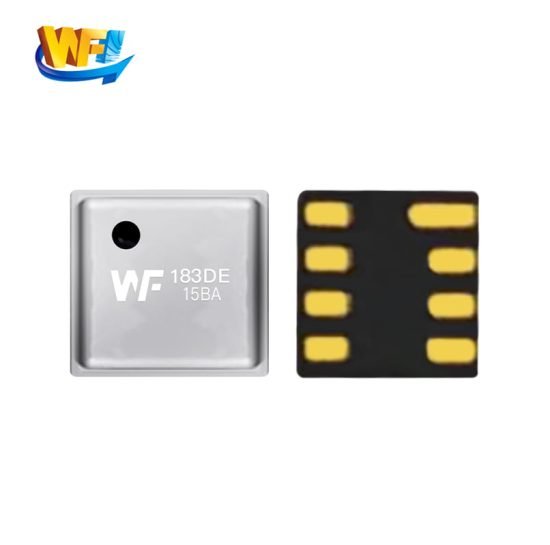Suction cups are very sensitive to vacuum level and response speed; sensors must give millisecond response, stable absolute-pressure readings and resistance to contamination. With digital outputs and local signal conditioning, sensors convert physical pressure into precise signals for the control loop, enabling closed-loop control, coordinated suction and safety measures. The pictured part is an LGA-packaged MEMS absolute-pressure sensor with a top vent hole — a good fit for integration into the suction cup’s core unit.
カタログ
1. Sensor decision logic and threshold control
The pressure sensor continuously samples the cavity’s absolute pressure and compares it to preset thresholds to confirm whether suction has succeeded. Systems should use high sampling rates and low-noise signal conditioning so they can spot key threshold changes — for example around -80 kPa — at the moment of contact and during initial sealing. The sensor also provides closed-loop feedback for vacuum maintenance; if cavity pressure rises past the safe band, the controller can top up vacuum or trigger an alarm immediately to prevent workpiece slippage and support quick decision-making.

2. Adaptive suction-force adjustment
Dynamic matching of power and force via pressure feedback
The pressure trace from the sensor is used to match vacuum pump power and valve opening in real time, so the system adapts to different loads and surface types. For light loads or smooth surfaces, the system keeps pump power low to save energy; for heavy loads or rough surfaces, sensor feedback drives pump boost or multi-stage sealing to compensate for leaks. When handling flexible or curved items, pressure fluctuations indicate contact quality and can prompt angle adjustments or local seal reinforcement to keep suction stable.
3. Leak detection and fault protection
A dual approach: rapid response plus progressive warning
If the sensor sees a sudden pressure rise inside the cavity, it can trigger immediate protections such as stopping the pump, engaging mechanical locks and raising an alarm to prevent a drop. For slow leaks, trend-based algorithms on pressure changes issue maintenance alerts so seals can be replaced before an incident. Long-term sensor reliability should combine anti-contamination designs (like isolation membranes or IP-rated housing) with temperature compensation to avoid false alarms or failures caused by the environment.
4. Energy management and efficiency gains
Demand-driven actuation and multi-cup coordination
Using sensor data to start/stop pumps, control valves and hold local pressure dramatically cuts idle power. In multi-suction setups, pressure readings from each cup balance force distribution to avoid local overload or panel warping. High sampling rates and on-board digital filtering lower control loop bandwidth needs, improving overall system efficiency and consistent response.
5. Safe release and damage-free separation
Controlled venting and sensor-backed reverse-blow cleaning
During release, the sensor monitors how quickly pressure returns to ambient and controls the unload rate so brittle parts don’t shatter and precision items aren’t damaged. Sensors also validate reverse-blow cleaning: after a short positive-pressure pulse, pressure recovery is checked before restarting suction, ensuring surface cleanliness and safe, continuous operation.
結論
Using high-performance pressure sensors as the suction cup’s core is essential for stable grip, safety and energy management. The right sensor should offer a high sampling rate (recommend ≥1 kHz), digital outputs (I2C/SPI or UART), contamination-resistant packaging and temperature compensation, paired with low-latency signal conditioning and closed-loop control. Digitalising pressure and folding it into control logic lets the suction system stay reliable under complex loads and conditions, reducing risk and boosting throughput.
上記の紹介は、圧力センサー技術のアプリケーションの表面をなぞっただけです。私たちは、さまざまな製品で使用されているさまざまなタイプのセンサー素子、それらがどのように機能するか、そしてそれらの長所と短所を引き続き調査していきます。ここで説明する内容についてさらに詳しく知りたい場合は、このガイドの後半にある関連コンテンツをご覧ください。時間がない場合は、ここをクリックしてこのガイドの詳細をダウンロードすることもできます。 空気圧センサー製品PDFデータ。
他のセンサー技術の詳細については、こちらをご覧ください。 センサーページにアクセスしてください。
